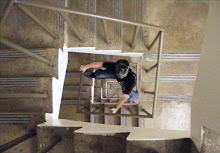*This is a paper I wrote a couple months back comparing two distinguished authors' takes on the fall of Rome. Kind of dry I imagine, but something I find interesting.
Over the years, countless historians, and college students, have studied the fall of the Roman Empire. And as can be expected, many different interpretations of the fall have been spread and discussed. Some, such as author Peter Brown, believe a more contemporary view, developed within the past few decades. This viewpoint treats the fall of the Roman empire not so much as a collapse or demise of a society, but rather a transformation of a culture because of outside influences. This belief focuses on the spread of religion and the accommodation of barbarian culture as some of the main driving forces behind that cultural change. Others, such as Bryan Ward-Perkins, believe that the fall of the Roman empire was indeed a collapse of a society, and resulted in the dramatic decline of standard of living and economic prosperity for most of the former empire. For these people, the invasion of barbarians was indeed an invasion, with violence and force at the front of the actions. Bryan Ward-Perkins' The Fall of Rome and the End of Civilization and Peter Brown's The World of Late Antiquity exemplify the two opposite viewpoints that are among the most often discussed.
One of the key areas on which Peter Brown and Bryan Ward-Perkins differ is the interpretation of the coming of the Germanic peoples, or simply "the barbarians," to the Roman Empire, and the result. Ward-Perkins said in his book that Brown "was able in his book to narrate the history of these centuries [200 AD - 700 AD] 'without paying lip service to the widespread notion of decay'" (Ward-Perkins 4). This aptly sums up the view of Brown's book on the barbarians. In fact, Brown has only one chapter discussing the role of the Germanic peoples within the Western and Eastern Roman Empires, and within that section uses the very word invasion when paired or associated with "so-called." Brown says of the invasions:
These invasions were not perpetual, destructive raids; still less were they organized campaigns of conquest.Rather, they were a 'gold rush' of immigrants from the underdeveloped countries of the north into the rich lands of the Mediterranean(Brown 122).
A rather different outlook on the situation, and almost completely doing away with the notion of violent invasion once so-often associated with the barbarians. The barbarians arrived in the West facing a society fragmented by its own heightened sense of identity and increased boundaries, leading to an intolerance of those different to them, even, or especially, within its own empire. The conflicting forces of the pagan Latin culture and the new-come Christian cultured created an empire that lacked the strength to resist the oncoming barbarian tribes, and one that was so inflexible that it couldn't influence the barbarian incursion enough to preserve their own Roman life (Brown 122). But because of the stagnant nature of the Roman senate and military, the barbarians found themselves in a position of high power. Barbarian warrior-aristocracy was integrated into the system by being offered posts of in the High Command. But with the Roman aristocracy resenting having to include barbarians within the power structure, and the Catholic Church unwilling to accept such men of war as the barbarians, the powerful barbarians were surrounded on all sides by hostility if not out-right opposition (Brown 124-125). And because of this, the barbarian tribes were forced to maintain their own identity, and as such were in a better position to change the nature of Roman society than the Romans to change barbarian society.
War-Perkins, however, has a rather different point of view. Unlike Brown, he maintains that the incursion of the barbarians was indeed a violent invasion, one that was decidedly unpleasant for the Roman people, especially those of the Western empire. For him, the barbarians "seized or extorted through threat of force the vast majority of the territories in which they settled, without any formal agreement on how to share resources with their new Roman subjects" (Ward-Perkins 12). Many historians typically cite a treaty between Rome and the Visigoths in 419, in which the Visigoths were granted some land in Aquitaine, but by the end of the century, the area of land controlled by the Visigoths had expanded in all directions, claiming an area of land many times larger than the original grant, and this land was taken either by force or threat of force from the Roman government or Roman provincials (Ward-Perkins 14). Even within Italy itself, the Emperor was forced to grant an extensive tax relief to the people up and down the peninsula, for the damage caused by Goths marching throughout the peninsula between 401 and 412, and a separate force of Goths that invaded the north-central region of Italy between 405 and 406. The damage was so great that even with the vastly reduced taxes, some provinces were still unable to pay them up to ten years after the invaders had left (Ward-Perkins 16).
Peter Brown's and Bryan Ward-Perkins' books all differ based what each does not talk about. In his book, Ward-Perkins chooses not to address the factor of religion with regard to the fall of Rome, other than to mention theories of historians such as Gibbon and A.H.M. Jones, in which the latter said, "the Christian church imposed a new class of idle mouths on the resources of the empire . . . a large number lived on the alms of the peasantry, and as time went on more and more monasteries acquired landed endowments which enabled their inmates to devote themselves entirely to their spiritual duties" (Ward-Perkins 41). Or, as Gibbon put it more succinctly, these are the "specious demands of charity and devotion" (Ward-Perkins 41). Ward-Perkins acknowledges these theories as having some effect on the fall of the empire, but he moderates them by paying so little attention to their subject. In contrast, a very large portion of Brown's book is dedicated largely to the effect of Christianity and religion on the transformation of the empire. The new barbarian rulers helped to spread Catholicism, because within the territories that once comprised the Western Roman empire, it was now an actual worry that Roman culture would be submerged, so the Church began asserting itself, trying harder and harder to create a united culture that could resist change. However, with more and more people converting to the Catholic faith, it was becoming more and more common for common people to focus more on their own smaller communities and their local ties, further strengthening the divisions created by the various gothic tribes (Brown 126-127). In their struggle to resist change, the people in turn changed further from the more united front needed to preserve the Roman culture as it once was.
As Ward-Perkins disregards religion within his book, so Brown chooses to ignore the more economic side of the fall of Rome, which Ward-Perkins chooses to dedicate several chapters to. Ward-Perkins uses several different sources to prove that in the post-Roman West, the economic decline was such that the standard of living for most areas declined to levels before the foundation of the Roman Empire. Chief among the evidence used is of pottery and coins. With regard to pottery, after the decline of the empire, material sophistication vanished. Markets that once distributed basic but still well made items to middle and lower class citizens were no longer in existence. In looking at the locally distributed pottery found in areas such as Britain, when compared with the quality of Roman times, the pottery found was extremely less friable and impractical (Wards-Perkins 104). In addition, the quantity of post-Roman pottery decreased dramatically, meaning that circulation of household goods had likely ground to a halt. And with regard to coins, the daily use of coinage had virtually disappeared in many areas of the post-Roman West (Ward-Perkins 111). These coins were once used daily, and were a fair indicator of the economic sophistication of the empire, and their absence indicates a decrease in levels of sophistication for much of the West. For most areas, without copper coins to facilitate small trade, and with no new coins being minted, much of the exchange in small markets would be done in barter or raw bullion for larger purposes (Ward-Perkins 118). With some exceptions, economic levels had dropped significantly for much of the empire.
The debate concerning the fall of the Roman empire will never truly end. There are so many theories and facts to be found, that any attempt for one overriding theory would never completely cover everything. However, the constant debate and comparison of the various arguments help to bring to light the general trends that expose as much of the truth as possible. As to which theory is more correct? As with most historical arguments, there is no black and white answer. History is painted in shades of gray, and it's up to us to try and complete the picture.
Thursday, March 4, 2010
Subscribe to:
Post Comments (Atom)








No comments:
Post a Comment